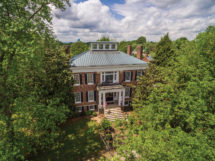How would you like to sit down to an 18th-century supper, and then spend the evening talking with a historic figure who lived during that time? It’s not as far-fetched as it sounds, for every Saturday night in February, Fort Boonesborough State Park near Winchester will host a series of “Fireside Chats” in one of its blockhouses.
Guests first sit down to a taste of frontier fare, such as buffalo stew, then settle back as character actors with the Kentucky Humanities Council’s Chautauqua, portraying historic figures such as Daniel Boone, Simon Kenton and George Rogers Clark, hold forth on their life and times and field questions from guests.
The Fireside Chat program is but one of a series of events at Fort Boonesborough, which was originally established as Kentucky’s second settlement by Daniel Boone and his men in 1775. Now the facility has been reconstructed as a working fort complete with blockhouses, cabins and furnishings.
During regular seasonal hours from April through the end of October, you can explore this treasure during a self-guided living history interpretive tour that starts with a 15-minute video about the fort’s beginnings.
“To my knowledge, Fort Boonesborough is the only state park in Kentucky where you can come in and see what frontier life was like, depicted by 12 to 15 people in 18th-century clothing doing things that were done in the 18th century the way they were done then,” said Bill Farmer, the fort’s manager and living history coordinator. “You can interact with these people and ask questions. If you want to try your hand at spinning some wool, you can do that. If you want to pump the bellows at the blacksmith shop, you can do that. It’s a pretty unique opportunity for Kentucky visitors. We recommend allowing at least an hour to an hour-and-a-half to see it all.”
One cabin is devoted to the period’s lighting processes – grease lamps and lanterns. Candles are made on site from beeswax hardened in molds. You can watch leatherworking and soap making. A weaver produces linsey-woolsey, a pioneer cloth, while a potter crafts the basic utilitarian forms used in the 18th century.
In keeping with the era, a naturalist discusses the existing plants and animals and how fort occupants would have utilized them. Fires were commonly started with flint and steel at that time, and visitors can see demonstrations of the process, along with tomahawk throwing and the firing of flint guns.
In addition to expected state park amenities of camping, fishing, hiking, swimming, miniature golf, picnicking and a rentable multipurpose building, Fort Boonesborough hosts an impressive series of special events all year long (see sidebar).
One that takes place the weekend after Thanksgiving (November 24-25 this year) presents an opportunity to purchase some fairly unusual holiday gifts. During Winter Trade Days at the fort, merchants in period costumes set up shops and hawk items common in the 18th century but still useful today, including candle lanterns and hand-sewn clothing. Come May, there’s a similar 18th-Century Trade Fair. (There is no admission charge for either event).
A summer weekend event that has been offered the past two years is for women only. In June, “Women on the Frontier” features highly respected experts discussing the place of women in pioneer times. On Saturday there are demonstrations of skills women would have had to know to survive on the frontier. Attendees actually learn how to shoot a flintlock gun, throw a tomahawk and cook over an open fire. On Sunday, they participate in timed competitions in their new skills.
“Everybody hears about Daniel Boone and George Rogers Clark and all these guys who were great heroes and won the frontier,” Farmer said, “but none of them would’ve even been alive without a woman. And we’re happy to report that the ladies who have attended this event have had a lot more fun than they should have! It’s becoming very popular.”



















Add Comment